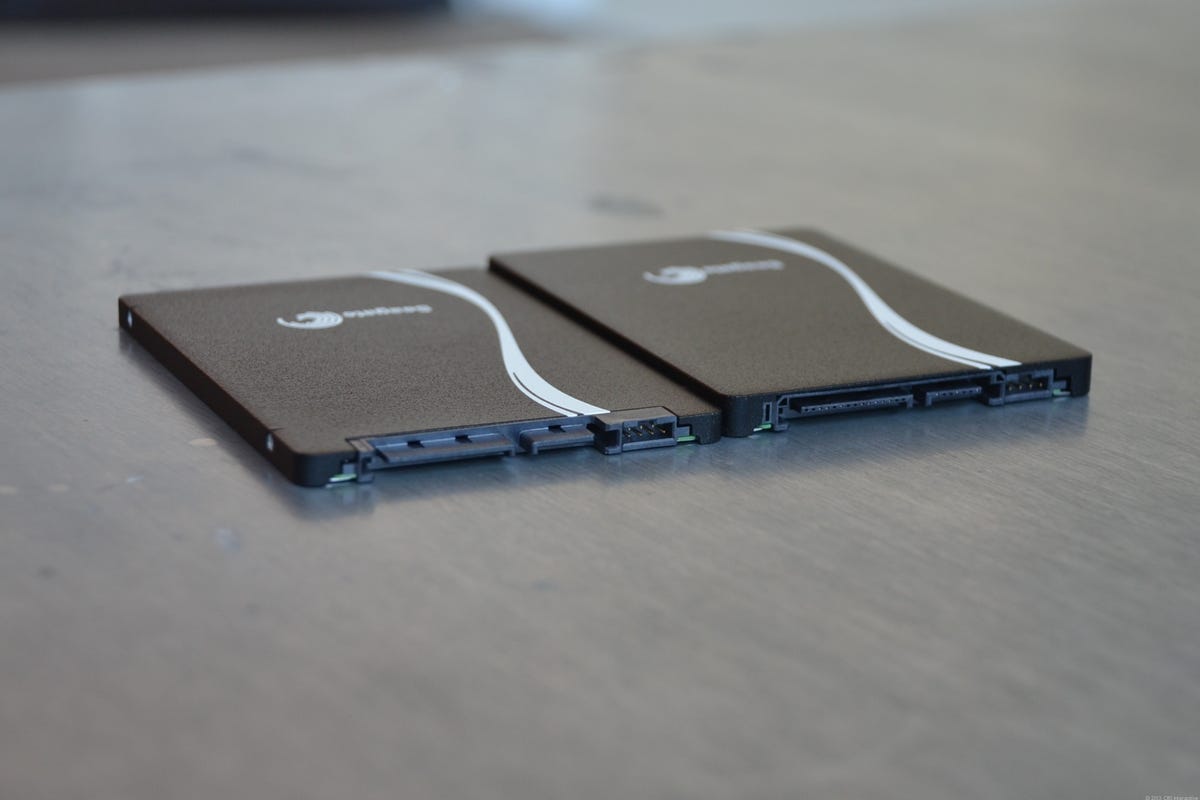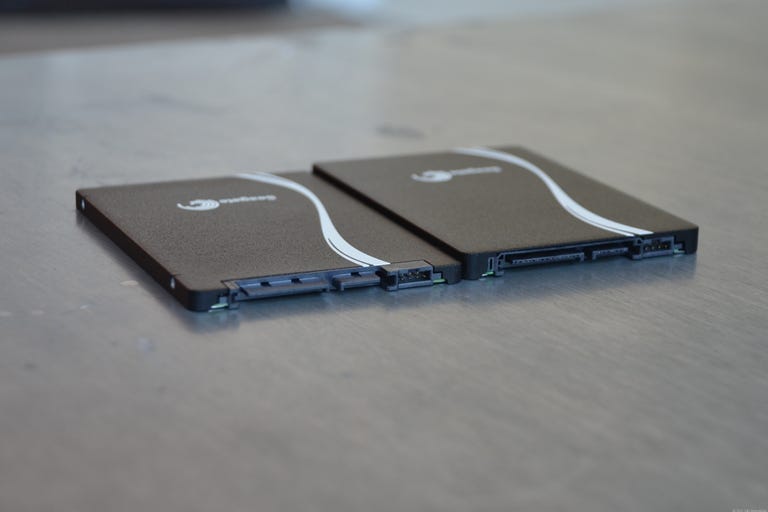 Why You Can Trust CNET
Why You Can Trust CNET Seagate 600 SSD review: Ultrathin, versatile and fast
Seagate's first solid-state drive for consumers is also the first on the market that's available in both 7mm and 5mm thicknesses. The drive offers fast performance at, hopefully, competitive pricing.
The Seagate 600 SSD is a major addition to the solid-state drive market. The drive is the first consumer-grade SSD to come from Seagate, which, prior to this, offered general consumers only regular platter-based storage solutions.
The Good
The Bad
The Bottom Line
It's also the first SSD that's available in both 7mm and 5mm designs, making it the most versatile SSD option. The drive can fit in a whole range of applications, from regular desktops to laptops, to many ultrabooks, and possibly some future tablets.
In my testing, the new drive offered very fast performance, proving itself to be a great alternative to even the speediest hard drive, and even faster than many other SSDs on the market.
On the downside, the 600 SSD has the same power consumption as a regular 5,400rpm laptop hard drive and comes with very high suggested retail price of $330 for 240GB (or $600 for 480GB, and $200 for 120GB). As with most new SSDs, though, the actual street price should be much lower when the drive actually ships early next month.
If you can wait until then, the Seagate 600 SSD will surely make an excellent buy. Otherwise, check out the alternatives on this list, which are available now.

| Drive type | 5mm- or 7mm-thick, 2.5-inch standard internal solid-state drive |
| Connector options | SATA 3 (6Gbps), SATA 2, SATA |
| Available capacities | 120GB, 240GB, 480GB |
| Product dimensions | 2.5-inch standard |
| Capacity of test unit | 480GB |
| Controller | Link A Media Device’s LM87800 |
| Flash memory type | 19nm Toshiba 2-bit-per-cell MLC NAND |
| OSes supported | Windows, Mac, Linux |
First standard 5mm design
The Seagate 600 SSD uses the standard 2.5-inch laptop design but is available in two thicknesses, 7mm and 5mm. While the 7mm is currently the most popular thickness for SSDs, the 5mm thickness is newer and was first introduced in the WD Blue hard drive. This design is made for ultrathin devices, including ultrabooks and future tablets.
The difference in thickness doesn't affect the drive's capacities or performance. Each of the two thicknesses is available in three capacities -- 120GB, 240GB, and 480GB -- with exactly the same performance ratings. The 240GB and 480GB capacities are able to offer up to 500MBps and 400MBps in sequential reading and writing, respectively. They offer random read and write speeds of up to 80K-IOPS (input/output operations per second) and 70K-IOPS, respectively. The 128GB capacity, however, has a slightly slower write speed rating of 300MBps for sequential writing and up to 60K-IOPS in random writing.
As with all new internal drives, the Seagate 600 SSD supports the latest SATA 3 (6Gbps) and comes with the standard SATA connector. This means the new SSD can be used in any situation where a standard SATA hard drive is used. It doesn't comes with a 3.5-inch drive-bay converter, however, which would make it easier to install in a desktop. This is not a deal-breaker, however, since you can just leave the drive hanging loose inside a computer chassis. Having no moving parts, SSDs don't need to be attached securely to the chassis to work properly. You can also buy a drive-bay caddy from a third party.
On the inside, the new 600 SSD uses Link A Media Device's LM87800 SSD controller, the same controller used in the high-end
According to Seagate, the 600 SSD can be used exactly the same way as any Seagate 2.5-inch standard hard drive, but it should be used with Windows 7 (SP1) or Windows 8 to ensure the proper use of the TRIM functionality. In my trials, the drive also worked with Linux and Mac OSes. It's unclear how well TRIM is supported on a Mac, however.
Hard-drive-like power consumption
The new 600 SSD consumes about the same amount of power as a regular 5,400rpm hard drive. It requires about 950mA on startup and about 4W maximum power during operation and about 1W when idle.
For a desktop this is not a big deal at all, but for a portable system, this won't help with battery life. To be fair, the 600 SSD still uses much less energy than other SSDs on the market, though it's also significantly less energy-efficient than those from Intel, OCZ, and especially Samsung. The Samsung 830 series, for example, uses just 0.24W during operation and 0.14W when idle; the Samsung 840 series uses even less.
"Competitively priced"
The Seagate 600 SSD comes with very high suggested retail price of around $200 for 120GB, $330 for 240GB, and $600 for 480GB. Seagate assures me that when the drive starts shipping, its street price will be very "competitive." Considering most SSDs now cost around $1 per gigabyte, you might expect the 600 SSD to cost about the same.
Performance
I tested both the 5mm and 7mm versions of the 480GB Seagate 600 SSD, and the two versions offered the same performance, which is very good.
As a secondary drive, the Seagate 600 SSD offered the real-world sustained write speed of 259MBps, which is above average among all SATA 3 SSDs. In the reading test, it did better with 275MBps, ranking it second fastest just after the 278MBps of the OCZ Vector.
When used as the main drive that hosts the operating system and performing both writing and reading at the same time, the Seagate 600 SSD offered the sustained speed of 137MBps.
The drive markedly helped improve the overall performance of the computer. The test system took just about 11 seconds to boot up and about 5 seconds to shut down, much faster than when it used a hard drive as its main storage. The computer also awoke from sleep mode instantly. Applications are loaded much more quickly. Compared with other high-end SSDs, however, the Seagate 600 SSD was about the same. Since SSDs are generally very fast compared with standard hard drives, it's hard to quantify the difference between them when it comes to the overall performance of a computer.
One thing I noted about the Seagate 600 SSD is that in some ways it behaved very similarly to a standard hard drive. For example, it takes about the same time to be formatted as a hard drive. Most other SSDs generally took a little longer to be quick-formatted.
(In seconds; shorter bars indicate better performance)
| Shutdown | Boot time |
(In Mbps; longer bars indicate better performance)
| As secondary drive (read only) | As secondary drive (write only) | As OS drive (read and write) |
Conclusion
Seagate is one of the largest storage vendors, and the release of the 600 SSD signifies that solid-state storage has become a mainstream alternative to regular hard drives. A little late to the solid-state game, Seagate has done a good job nonetheless with the 600 SSD, which has proven to be a fast and versatile internal storage device.


